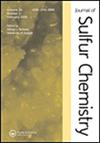Vachelia nilotica seed-mediated green synthesis of sulfur nanoparticles (SNPs) and evaluation of anticancer & antifungal activities
IF 1.6
3区 化学
Q3 CHEMISTRY, MULTIDISCIPLINARY
引用次数: 0
Abstract
Sulfur nanoparticles (SNPs) have been successfully synthesized by applying Vachelia nilotica seed extract as a bioactive aqueous material by a disproportionation reaction of sodium thiosulfate pentahydrate (Na2S2O3.5H2O) with a 10% hydrochloric acid (HCl) at room temperature. The synthesized SNPs were characterized by UV–Visible, Fourier Transform Infrared (FTIR) spectroscopy, Scanning Electron Microscopy (SEM), Transmission Electron Microscopy (TEM), Energy-Dispersive X-ray Spectroscopy (EDS), and X-ray Diffraction (XRD) techniques. The usual size of SNPs was determined by an XRD study and calculated with the Debye–Scherrer formula. The SNPs are crystalline with a calculated average size of 45 nm. The SEM and TEM analyses revealed spherical shape and size around 55 nm of SNPs. The synthesized SNPs were screened for their antifungal activity against M. furfur species and for anticancer activities against (MCF-7, HepG2) cell lines. The obtained results suggested towards moderate to good antifungal and excellent anticancer activities.
黑麦草种子介导的硫纳米粒子(SNPs)绿色合成及其抗癌和抗真菌活性评估
以黑醋栗种子提取物为生物活性水性材料,通过硫代硫酸钠与硫酸铜的歧化反应,成功合成了硫纳米粒子(SNPs)。
本文章由计算机程序翻译,如有差异,请以英文原文为准。
求助全文
约1分钟内获得全文
求助全文
来源期刊

Journal of Sulfur Chemistry
CHEMISTRY, MULTIDISCIPLINARY-
CiteScore
4.10
自引率
9.10%
发文量
38
审稿时长
6-12 weeks
期刊介绍:
The Journal of Sulfur Chemistry is an international journal for the dissemination of scientific results in the rapidly expanding realm of sulfur chemistry. The journal publishes high quality reviews, full papers and communications in the following areas: organic and inorganic chemistry, industrial chemistry, materials and polymer chemistry, biological chemistry and interdisciplinary studies directly related to sulfur science.
Papers outlining theoretical, physical, mechanistic or synthetic studies pertaining to sulfur chemistry are welcome. Hence the target audience is made up of academic and industrial chemists with peripheral or focused interests in sulfur chemistry. Manuscripts that truly define the aims of the journal include, but are not limited to, those that offer: a) innovative use of sulfur reagents; b) new synthetic approaches to sulfur-containing biomolecules, materials or organic and organometallic compounds; c) theoretical and physical studies that facilitate the understanding of sulfur structure, bonding or reactivity; d) catalytic, selective, synthetically useful or noteworthy transformations of sulfur containing molecules; e) industrial applications of sulfur chemistry; f) unique sulfur atom or molecule involvement in interfacial phenomena; g) descriptions of solid phase or combinatorial methods involving sulfur containing substrates. Submissions pertaining to related atoms such as selenium and tellurium are also welcome. Articles offering routine heterocycle formation through established reactions of sulfur containing substrates are outside the scope of the journal.
 求助内容:
求助内容: 应助结果提醒方式:
应助结果提醒方式:


